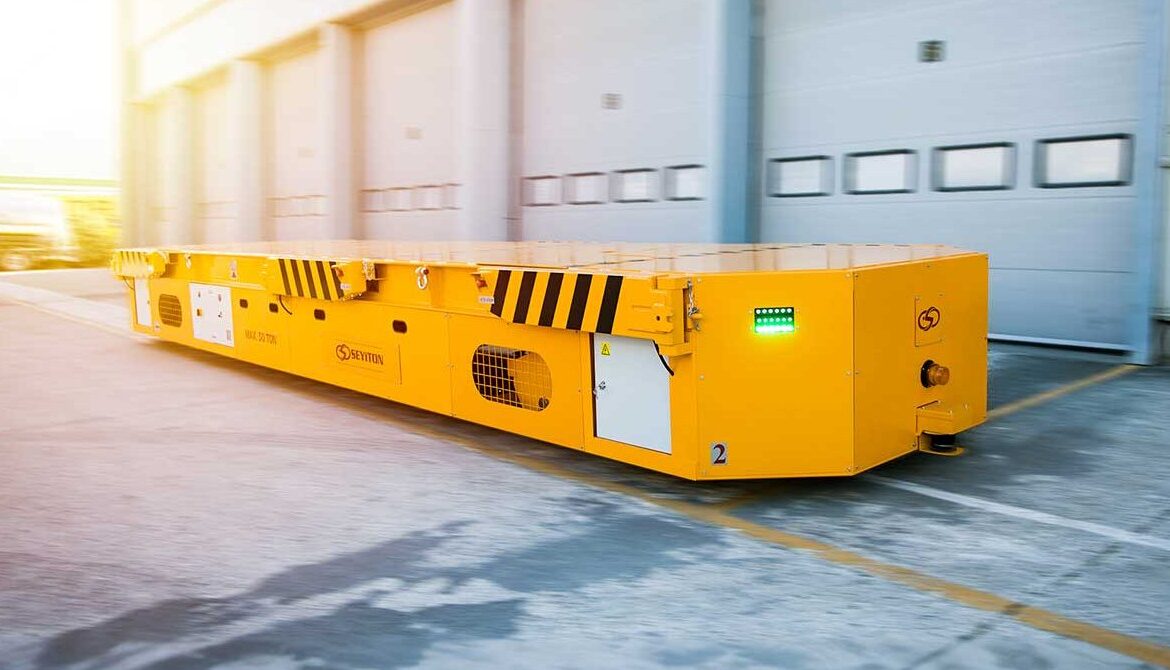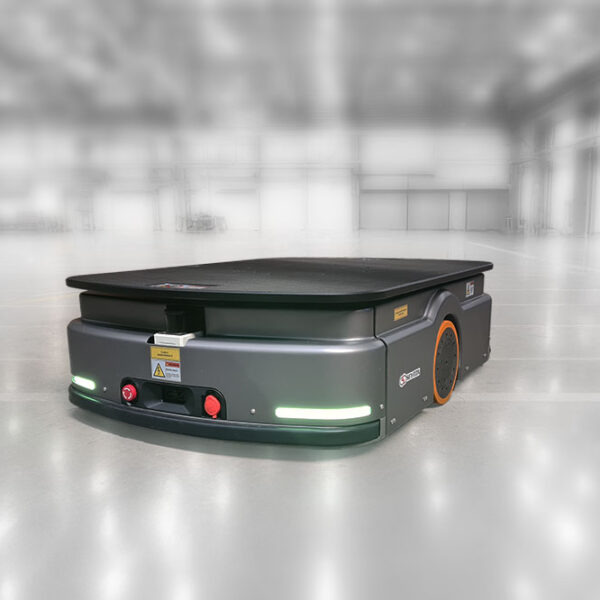WHAT IS A INDUSTRIAL TRANSFER CART?

A transfer cart is an industrial material handling vehicle that moves heavy loads across factory floors. These electric-powered carts are commonly used in industrial plants, production workshops, and warehouses as a cost-effective, safe, and flexible solution. They serve as a reliable alternative to traditional equipment such as forklifts or cranes, particularly when their capacity or safety limitations are reached. Today, transfer carts are increasingly used in place of forklifts and cranes to improve safety and reduce operational costs.
Table of Contents
ToggleRail Transfer Carts: Speed and Safety on the Production Line
Rail-based transfer carts run along steel rails fixed to the factory floor. These carts are typically used for regular, repetitive material transfers across set paths. The key advantage of rail-based transfer carts is that the load is securely supported by the track, which minimizes the risk of tipping over or instability during transit. These models can operate at speeds of up to 40 meters per minute and are capable of moving heavy loads quickly and without interruption. Rail-based transfer carts are commonly used in industries such as steel manufacturing, where hot metal ladles or steel coils need to be moved between stations or furnaces, ensuring safe and efficient material transfer.
One of the primary benefits of rail-based transfer carts is their ability to support heavy loads without the risks of imbalance or tipping, which are often seen with forklifts. Additionally, these carts ensure continuous movement along a set route, allowing multiple carts to operate in synchronization, which increases throughput and efficiency.
Steerable (Trackless) Transfer Carts: Flexibility and High Maneuverability
For environments where rail-based systems are impractical, wheel-based (trackless) transfer carts are an ideal alternative. These carts are equipped with special wheels and advanced steering systems that allow them to move freely on the factory floor, without the need for fixed tracks. Trackless transfer carts can be equipped with capabilities like 360-degree rotation or crab-walking to maneuver easily in tight spaces.
The advantage of wheel-based transfer carts is their flexibility in navigating through complex or changing factory layouts. These carts can easily operate across multiple production lines or transport materials between different areas without the restrictions of fixed routes. High capacity models are capable of carrying loads ranging from 5 tons to 500 tons. These carts are particularly useful in environments that require frequent route changes or those with irregular layouts, making them a versatile choice for industries such as automotive manufacturing, aerospace, and heavy machinery production.
Trackless carts also enhance worker safety and reduce labor costs. By using these automated carts, businesses can reduce the number of workers required for material handling, freeing up personnel for other tasks. Moreover, their autonomous capabilities reduce the chances of human error and injury, ensuring smoother operations and less downtime.
Autonomous Transfer Carts (AGVs/AMRs)
Transfer carts can also be autonomous, offering automated material handling without the need for an operator. Automated Guided Vehicles (AGVs) and Autonomous Mobile Robots (AMRs) are the next generation of transfer carts that use sensors, lasers, and advanced software to navigate and operate autonomously.
AGVs follow predetermined paths marked by magnetic strips, reflectors, or guide tracks, ensuring safe and reliable material transfer. These vehicles are perfect for predictable, repetitive tasks such as assembly line feeding and warehouse operations.
AMRs, on the other hand, use advanced sensors like LIDAR scanners, cameras, and QR code readers to create a real-time map of their environment. These robots can navigate dynamic, changing environments and re-route themselves as needed, avoiding obstacles and adjusting their paths on the fly. AMRs offer maximum flexibility and efficiency, as they can adapt to changing floor plans and optimize their routes autonomously.
AMRs and AGVs improve production efficiency and safety, while also reducing labor costs. They can work 24/7 without the need for breaks, ensuring a continuous flow of materials throughout the factory, even during night shifts.
Benefits of Transfer Carts
Transfer carts provide numerous benefits over traditional material handling systems such as forklifts and cranes:
Enhanced Safety and Reduced Accidents: Transfer carts are designed with safety in mind, with features such as load stabilization systems and advanced sensors to avoid accidents. Unlike forklifts or overhead cranes, which involve risks of load shifting, tipping, or falling, transfer carts securely hold materials, reducing the chances of workplace injuries.
High Load Capacity and Increased Efficiency: Transfer carts, especially those with high load capacities, can transport significantly heavier materials than forklifts or other conventional equipment. This allows factories to move large components quickly and without unnecessary downtime, improving operational efficiency.
Labor and Cost Savings: By reducing the need for multiple workers or forklifts, transfer carts lower labor costs. Moreover, their automation and reliable operation minimize the risk of errors and accidents, leading to further cost savings and increased productivity.
Flexibility and Integration: Transfer carts can be easily integrated into existing factory layouts and workflows. Unlike traditional systems like conveyors or cranes, which require fixed tracks or overhead structures, transfer carts can be used in dynamic environments. They can adapt to changes in factory floor layout, allowing businesses to modify their operations quickly without significant downtime or additional costs.

